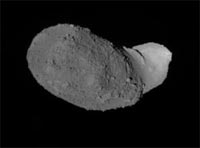 |
|||||||

The first day of the 19th century is the birthday of asteroid studies. On January 1, 1801, Giuseppe Piazzi, an astronomer and a priest, discovered the asteroid "Ceres" at an astronomical observatory in Sicily, Italy.
You may not be familiar with asteroids, but almost 100,000 of them have been found over two centuries since the first discovery. The diameter of an asteroid is smaller than that of a planet which is usually about several thousand kilometers to several hundred thousand kilometers. The diameter of the Ceres, which is one of the largest asteroids, is about 1,000 kilometers. The Itokawa is one of the smaller asteroids, and its diameter is 500 kilometers or a bit longer than the length of a bullet train (Shinkansen). Those who imagine a huge heavenly body whenever you hear about a "star" may be disappointed to learn the size of the Itokawa. So, why is such a small asteroid important? Why are we working hard to try to get there? One reason is that an asteroid is believed to be full of very old materials from the solar system as it is called a "fossil of the solar system." When you are asked about the shape of a star, you would probably imagine a spherical shape (I am not talking about a five-pint "star" shape.) Apart from fix stars, planets including the Earth, Mars and Venus are also spherical. This shape indicates that a star was once melted. It is believed that a large planet was melted at least once by gravitational energy and by the decaying heat of radioactive substances that slightly existed in stones and rocks. However, in the case of asteroids, the story is different. Whenever an asteroid is heated, it can quickly cool down because it is small. Therefore, it is believed that it has not been deformed by heat. That is why we have high expectations that, on the surface of a small asteroid, intact remnants of the solar system should exist.
» Story 3: Talk to the Hayabusa, which is 300 million km away, by using hand-written commands |
|
||||||
|
|||||||
 Photo: Asteroid Itokawa
Photo: Asteroid Itokawa